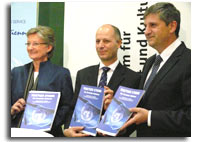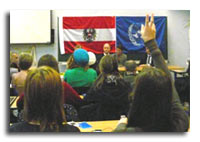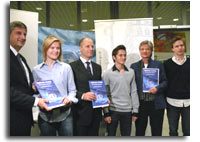 The Austrian Minister for Education Claudia Schmied, the Minister for European and International Affairs Michael Spindelegger and Director of UNIS Vienna, Maher Nasser, launched the teaching materials Together Strong - Die Vereinten Nationen (the United Nations) at an event in the Vienna secondary school Gymnasium Rahlgasse on 20 October 2009. Together Strong is a set of German-language teaching materials on the United Nations, published by the three partners in this educational project. Copies will be distributed free of charge to all secondary schools around Austria and already reactions from teachers and pupils are very positive. The launch event was timed to mark the upcoming United Nations Day (24 October), as well as Austria's Presidency of the United Nations Security Council in November 2009 and the 30th anniversary of the Vienna International Centre (VIC) this year.
The Austrian Minister for Education Claudia Schmied, the Minister for European and International Affairs Michael Spindelegger and Director of UNIS Vienna, Maher Nasser, launched the teaching materials Together Strong - Die Vereinten Nationen (the United Nations) at an event in the Vienna secondary school Gymnasium Rahlgasse on 20 October 2009. Together Strong is a set of German-language teaching materials on the United Nations, published by the three partners in this educational project. Copies will be distributed free of charge to all secondary schools around Austria and already reactions from teachers and pupils are very positive. The launch event was timed to mark the upcoming United Nations Day (24 October), as well as Austria's Presidency of the United Nations Security Council in November 2009 and the 30th anniversary of the Vienna International Centre (VIC) this year.
Welcoming the guests to the school, headmistress Heidi Schrodt referred to the Gymnasium's long history of multi-national education and pointed out that Rahlgasse was the first middle school for girls in the Austrian Empire, founded by women's rights activists at the end of the 19th century. In an interactive question and answer session, students of the class 4c (8th grade) had the opportunity to ask the Ministers and UNIS Director Nasser questions about the UN and Austria's relationship to the organization. "What is the UN doing for children's rights?", "What is Austria doing in the Security Council?" and "What do you do when two member states start fighting?" were answered with explanations of the Convention on the Rights of the Child, and of the role and work of the various United Nations organs, specifically the Security Council. Minister Spindelegger also pointed out that in addition to the daily work schedule, Austria would use its chairmanship of the body in November to highlight the issue of protecting civilian populations in armed conflict.
 "Following our EU Council Presidency in 2006, Austria's membership in the Security Council is the second most important international responsibility that we have assumed. We want to use this chance to bring the UN - its structure and procedures - closer to school children. In a small country such as ours, a knowledge of languages and an understanding of international networks are essential tools for the future," Minister Spindelegger said.
"Following our EU Council Presidency in 2006, Austria's membership in the Security Council is the second most important international responsibility that we have assumed. We want to use this chance to bring the UN - its structure and procedures - closer to school children. In a small country such as ours, a knowledge of languages and an understanding of international networks are essential tools for the future," Minister Spindelegger said.
His counterpart from the Ministry of Education, Culture and Art, Claudia Schmied, added: "Working on tomorrow's school also always means working on tomorrow's world. Our pupils will some day decide which direction we will take. This makes it very important that we start early in building an awareness of global issues and that we leave room for sustainable development in education. This is only possible if we teach not only the basic facts, but also give young people the tools for peaceful coexistence and democracy -- in the class room, as well as in the world as a whole. In this regard, these teaching materials are an important contribution towards the political education of our children." Pupils were also interested how a country could become a member of the United Nations, and what the employment prospects in the organization were, particularly for women.
 The teaching material was initially developed by UNIS Vienna to prepare visiting school classes for a tour to the VIC. Building on this material, additional chapters focusing on the relationship between Austria and the UN, as well as on the 30th anniversary of the VIC were added and are presented as printed materials, as well as on-line. The material is designed to correspond to the Austrian curriculum and offers pupils an overview of the history, structure and main functions of the UN. Aimed specifically at grade 7 and above, the material is age-appropriate and interactive and offers plenty of scope for further study, as well as hands-on exercises, such as a simluated Security Council debate.
The teaching material was initially developed by UNIS Vienna to prepare visiting school classes for a tour to the VIC. Building on this material, additional chapters focusing on the relationship between Austria and the UN, as well as on the 30th anniversary of the VIC were added and are presented as printed materials, as well as on-line. The material is designed to correspond to the Austrian curriculum and offers pupils an overview of the history, structure and main functions of the UN. Aimed specifically at grade 7 and above, the material is age-appropriate and interactive and offers plenty of scope for further study, as well as hands-on exercises, such as a simluated Security Council debate.
Director Maher Nasser: "With the help of this book, Austrian school children will be able to take a first step into the world of the United Nations, learn about its structure, its history and its role. They will also find pointers where to go for more information. The hope is that pupils will gain a better understanding of the organization and also of their own relationship to the United Nations and what the organization is doing to address the increasingly globalized challenges of the 21st century."
A free for download on-line version is available on the UNIS website and on the teachers' portal.